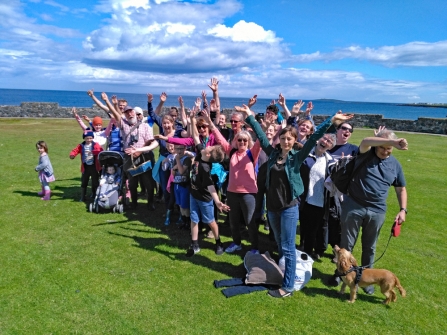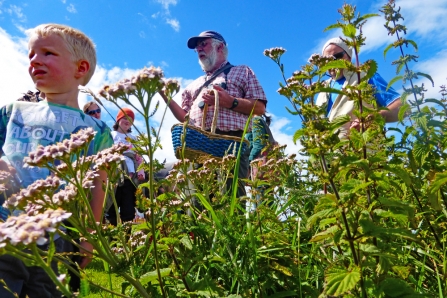Meandering from the harbour car-park towards Ballymacormick Point we collected the best of what was on offer mere meters from the path, in preparation for a camp-stove feast on paltry periwinkles, succulent samphire and sea-beet, and decidedly more slimy seaweeds. With sound advice to select from the parts of the plant taller than a dog can wee! - our knowledgeable guide Dermot Hughes from Forage Ireland pointed out what edible seeds were on offer to us in early August, including yarrow and nettle seeds.
Coastal Foraging – Fine Dining at Groomsport

We learned what plants to take care around, specifically members of the Umbellifer family: there are a number of edibles in the midst of the Carrot family, including dainty cow parsley (Anthriscus sylvestris) which adorns our hedgerows from early spring, and coastal Alexanders (Smyrnium olusatrum). However, the lethal hemlock water dropwort (Oenanthe crocata) can be mistaken for their tastier cousins to the untrained eye. Potential foragers need to be quite confident in their identification skills before tangoing with the Carrot family.
As we ambled closer to the sea things started to get more refined, with a fringe of samphire (Salicornia europaea in this case) delighting the discerning diner on the salt-marsh fringe at Ballymacormick. Samphire is quite the fashionable vegetable, seeing a real growth in popularity as the perfect salty accompaniment on restaurant menus. No need to go for the retailer (most likely imported!) version if you know where to look.

The real fun began in the rock pools, where we tuned our eye in to the common periwinkle (Littorina littorea), the beefiest of the periwinkles on our coast in size if not in flavour. With its large, drab shell and white lip it is fairly easy to recognise. For more of a mouthful we were advised to go for shells of at least 2cm or so in length. We kept our eyes peeled for mussels too, but it seemed in most cases something else got there first, as we only found empty shells.
Sustainability is the name of the game- under Dermot’s watchful eye, we only took what we were sure would be sampled by the group. Would-be foragers need to carefully think about where they forage, remaining aware of any special protections that may be in place in or near reserves. Coastal spots are often very popular with dog-walkers, so stray slightly from the most popular routes! And on coastal locations tides are an additional hazard to be aware of.
Upon return to the car-park, a pot was set to boil and our shelled creatures met their fate. Sea beet (Beta vulgaris subsp. maritima) and samphire were really delicious fried up in butter and garlic. Personally, after briefly abandoning vegetarianism in the face of curiosity, I couldn’t speak quite as enthusiastically about the periwinkles. It’s all a matter of personal preference though, as one young lad seemed to have found a new firm favourite in winkles, disposing of most of the collection personally! Thanks so much to all our incredibly eager partakers – everyone was really tuned in to Dermot’s wealth of information, and more than willing to taste-test the pickings.
Supported By:


